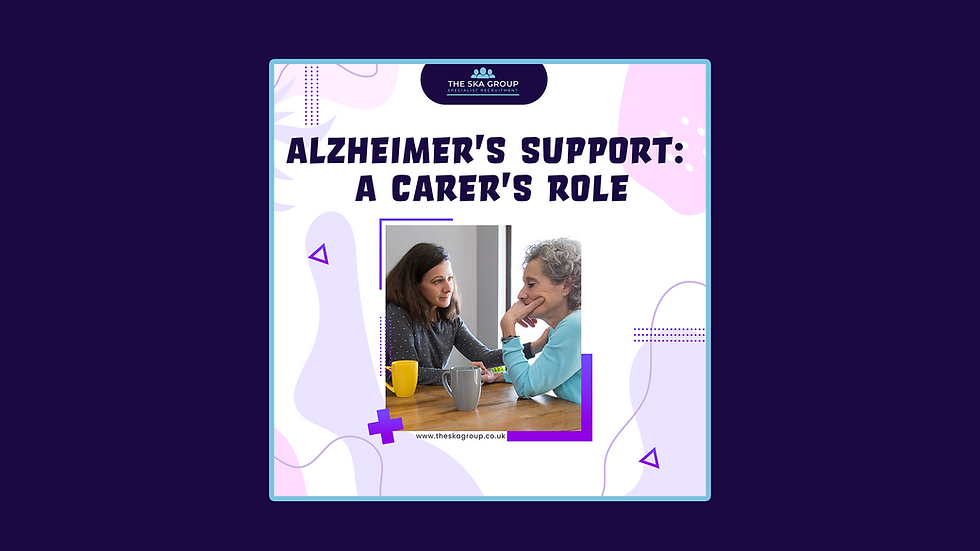Learning Disabilities: Breaking Myths, Building Understanding
- Emily

- Jun 16
- 4 min read
Learning Disability Week 2025 is a moment to reflect, recognise and re-educate. At The SKA Group, we work every day with people who have learning disabilities — and we know how capable, creative and valuable they are. Yet, too often, outdated myths and misunderstandings create barriers that can limit lives.
By increasing awareness and sharing the truth, we can break down stigma, encourage empathy, and ensure people with learning disabilities are supported in the ways they truly deserve.
What Are Learning Disabilities?
Learning disabilities are neurological differences that affect how a person processes information. They can make reading, writing, understanding numbers, or following instructions more challenging — but they do not reflect intelligence.
Common types include:
Dyslexia – challenges with reading and interpreting written language
Dysgraphia – difficulties with writing and fine motor coordination
Dyscalculia – problems with understanding numbers and mathematical concepts
These challenges may show up differently from person to person. It’s important to recognise that many people with learning disabilities have average or above-average intelligence — their potential is there; they just need the right support.
Myth 1: Learning Disabilities Are the Same as Intellectual Disabilities
This is one of the most common misconceptions — and it leads to misunderstanding and missed opportunities.
While both may affect learning, they are not the same. A learning disability impacts specific areas, such as reading or writing. An intellectual disability affects overall cognitive functioning and daily living. For example, someone with dyslexia might struggle with reading but excel in maths or science.
When we understand the difference, we’re better equipped to offer the support each person needs.
Myth 2: People with Learning Disabilities Just Need to Try Harder
This myth can be particularly damaging. People with learning disabilities are not lazy — in fact, many work twice as hard to keep up, which can lead to frustration and exhaustion.
Imagine spending hours on a short writing task because of dysgraphia, only to be told you’re not trying hard enough. What people need is patience, practical tools, and understanding — not blame.
Myth 3: Learning Disabilities Are Always Obvious
Learning disabilities aren’t always visible. A child might shine in creative arts but struggle in reading. On the other hand, a young adult might breeze through conversations but find written instructions overwhelming.
Because of this, learning disabilities are often misunderstood or missed altogether. Early identification and professional assessments are crucial — they open the door to the right strategies and support.
Myth 4: People Grow Out of Learning Disabilities
Learning disabilities don’t disappear with age — they evolve. With time, experience, and tailored support, people often develop ways to manage their challenges and succeed.
For example, someone with dyslexia may rely on audio books or speech-to-text tools. The disability doesn’t go away — but confidence and coping strategies grow. Our role is to support that journey, not expect people to "grow out of it."
The Harm of Myths and Why Awareness Matters
When society misunderstands learning disabilities, the impact goes beyond the classroom. It affects job prospects, confidence, mental health, and inclusion.
A survey by the National Center for Learning Disabilities found that nearly 1 in 3 adults with learning disabilities felt stigmatised. That stigma limits potential.
Breaking down these myths helps create a world where people are seen for what they can do — not just what they find difficult.
Building a Supportive Environment
Creating inclusive communities starts with awareness and practical action.
In schools: Train educators to spot signs early and offer adjustments that work — like extra time, assistive tools, or quiet spaces.
In workplaces: Provide accessible training, flexible expectations, and open conversations around neurodiversity.
At home: Talk openly about learning differences. Support from loved ones builds confidence and resilience.
Inclusion is not a one-size-fits-all model — it’s about listening, adapting, and valuing people for who they are.
Everyday Strategies That Make a Difference
For people with learning disabilities, the right tools and habits can empower independence and success:
Use assistive technology like text-to-speech apps, screen readers, or dictation software.
Break big tasks into smaller steps to reduce overwhelm.
Stick to routines that help build consistency and confidence.
Reach out for support — from mentors, tutors, or peer groups. No one has to navigate it alone.
The Role of Families and Carers
Family members play a huge part in supporting someone with a learning disability. You don’t need to have all the answers — just showing up with patience and a willingness to learn makes a world of difference.
Here’s how families can make an impact:
Stay informed: Learn about different learning disabilities and what support might help.
Communicate openly: Let your loved one share what works and what doesn’t.
Work with teachers and professionals: Be an advocate and an ally, especially in education and healthcare settings.
A supportive home lays the foundation for lifelong confidence.
Final Thoughts: Change Starts With Understanding
At The SKA Group, we believe everyone deserves to be recognised for their strengths — not defined by their challenges.
By learning the truth about learning disabilities, challenging old myths, and creating safe, inclusive spaces, we help people thrive. Whether you’re a teacher, friend, carer, employer, or family member — your awareness and support make all the difference.
Let’s use Learning Disability Week 2025 to listen, learn, and lead with empathy, because when we understand better, we care better.




Comments